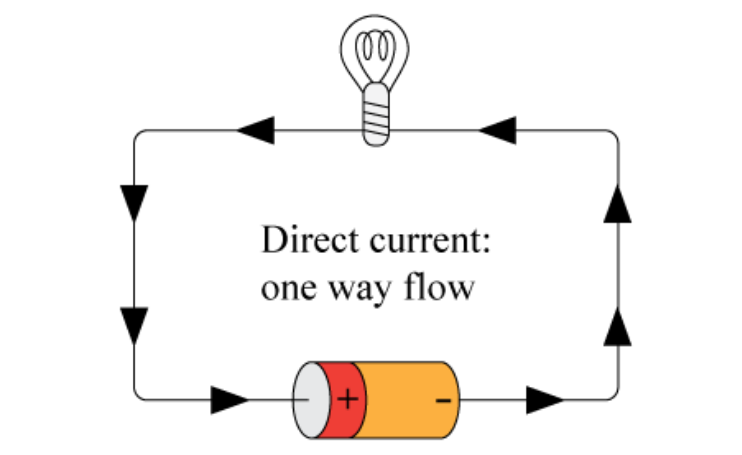Menu
Menu


Updated on Feb 2, 2024 | 6 min read
In electric vehicles, we understand that it requires both AC and DC for charging. Now, let’s understand in this blog what DC or Direct Current is and the technical aspect of the DC current.
DC, or Direct Current, is a type of electric current that flows consistently in one direction. In DC circuits, electrons move from a negative charge area to a positive charge area without changing direction, unlike in alternating current circuits, where the current reverses direction periodically.
Direct Current is the flow of electric charge that maintains a consistent direction over time.
The history of direct current began in 1800 when Italian physicist Alessandro Volta invented the Voltaic pile, producing the first DC. In the early 1800s, André-Marie Ampère proposed the flow of DC from positive to negative. Later, in 1832, Hippolyte Pixii’s first dynamo electric generator generated alternating current. Power stations emerged in the late 1870s and early 1880s, initially using high-voltage DC or AC for arc lighting. Thomas Edison’s introduction of low-voltage DC for indoor lighting in 1882 spurred competition with AC. However, AC gained prominence due to its advantages with transformers for longer transmission distances. In the mid-1950s, high-voltage DC transmission emerged as an alternative. Today, AC dominates power delivery, with DC reserved for specific applications such as undersea cables and certain rail systems.
Connect with 1C for expert advice on EV chargers
Direct current operates by maintaining a constant flow of electric charge in one direction. It is generated through various means:
Electrons, negatively charged particles, move from the negative terminal (cathode) to the positive terminal (anode) through an external circuit.
The flow of electrons powers electrical devices such as lights, motors, and electronic gadgets connected in the circuit.
The fundamental principle behind generating direct current involves creating a voltage potential that initiates a continuous flow of electric charge. This can be achieved through processes like chemical reactions in batteries or the movement of coils in a magnetic field in generators.
In a DC circuit, electric charge consistently flows in one direction. This steady flow is governed by Ohm’s Law (V=IR), where voltage (V), current (I), and resistance (R) are interconnected. DC finds applications in various fields, including electronics, automotive systems, and renewable energy. It serves as the foundation for electric motors, where the continuous current flow generates mechanical movement.
Connect with 1C for expert advice on EV chargers
A DC circuit consists of several key components that work together to facilitate the flow of direct current:
To measure DC current, a multimeter is used. It is connected in series with the load being measured.

The black probe (COM) of the multimeter is connected to the negative terminal of the battery, while the positive test (red probe) is connected to the load. The positive terminal of the battery is also connected to the load.
DC circuits can be categorised into three main types based on how components are connected: parallel DC circuits, series DC circuits, and series-parallel DC circuits.
The advantages of Direct Current are:
The disadvantages of DC Current are:
Direct Current has various applications listed below:
When an electric vehicle battery degrades over time, its performance gradually diminishes before reaching a point where the vehicle stops working entirely. This degradation is noticeable as the battery’s capacity decreases by 20 to 30% at the end of its service life. As the battery deteriorates with each charge-discharge cycle, it becomes unsuitable for powering the vehicle. If the battery dies while driving, the car will gradually slow down and stop, necessitating attention and roadside assistance.
© 2024 Massive Mobility Private Limited. All rights Reserved